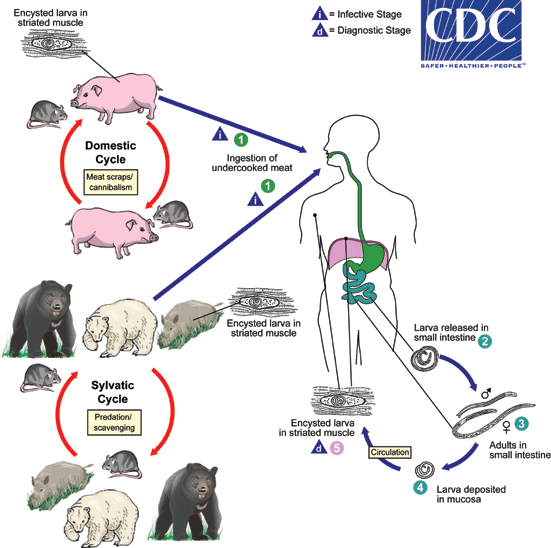Trichinosis pathophysiology
|
Trichinosis Microchapters |
|
Diagnosis |
|---|
|
Treatment |
|
Case Studies |
|
Trichinosis pathophysiology On the Web |
|
American Roentgen Ray Society Images of Trichinosis pathophysiology |
|
Risk calculators and risk factors for Trichinosis pathophysiology |
Editor-In-Chief: C. Michael Gibson, M.S., M.D. [1]
Pathophysiology
Trichinosis is a disease caused by eating undercooked meat containing cysts of Trichinella spiralis. Trichinella spiralis can be found in pork, bear, walrus, fox, rat, horse, and lion meat. Wild animals, especially carnivores (meat eaters) or omnivores (animals that eat both meat and plants), should be considered a possible source of roundworm disease. When a person eats meat from an infected animal, Trichinella cysts break open in the intestines and grow into adult roundworms. The roundworms produce other worms that move through the gut wall and into the bloodstream. These organisms tend to invade muscle tissues, including the heart and diaphragm (the breathing muscle under the lungs). They can also affect the lungs and brain.
Overview
Pathogenesis

- Trichinella spp. is usually transmitted via the [transmission route] route to the human host.
- Trichinellosis is acquired by ingesting meat containing cysts (encysted larvae) (1) of Trichinella.
- After exposure to gastric acid and pepsin, the larvae are released (2) from the cysts and invade the small bowel mucosa
- They develop into adult worms (3) (female 2.2 mm in length, males 1.2 mm; life span in the small bowel: 4 weeks).
- After 1 week, the females release larvae (4) that migrate to the striated muscles where they encyst (5).
- Trichinella pseudospiralis, however, does not encyst.
- Thirty to 34 hours after the cysts were originally ingested, the adults mate, and within five days produce larvae.
- The worms can only reproduce for a limited time because the immune system will eventually expel them from the small intestine.
- The larvae then use their piercing mouthpart, called the "stylet", to pass through the intestinal mucosa and enter the lymphatic vessels, and then enter the bloodstream.
- The larvae travel by capillaries to various organs, such as the retina, myocardium, or lymph nodes; however. Only larvae that migrate to skeletal muscle cells survive and encyst.
- Encystment is completed in 4 to 5 weeks and the encysted larvae may remain viable for several years.
- Ingestion of the encysted larvae perpetuates the cycle.
- Rats and rodents are primarily responsible for maintaining the endemicity of this infection.
- Carnivorous/omnivorous animals, such as pigs or bears, feed on infected rodents or meat from other animals.
- Different animal hosts are implicated in the life cycle of the different species of Trichinella.
- Humans are accidentally infected when eating improperly processed meat of these carnivorous animals (or eating food contaminated with such meat).